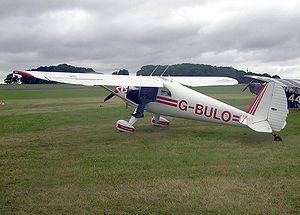Luscombe 8
| Luscombe 8F | |
|---|---|
 Luscombe 8F |
|
| Type: | single-engine sport aircraft |
| Design country: | |
| Manufacturer: |
Luscombe Airplane Development Corporation and |
| First flight: |
June 6, 1938 |
| Production time: |
1938-1949 |
| Number of pieces: |
2221 |
The Luscombe 8 (also Luscombe 50) is a 2-seat training and sports aircraft made by the US manufacturer Luscombe Aircraft Corporation in the 1930s and 1940s. Until 1937 the company operated as the Luscombe Airplane Development Corporation .
history
1938 to 1942
The first planning took place in 1937 and in June 1938 the first test flight was carried out. The Luscombe 8 developed by Don Luscombe was a great economic success for the company from the start. From the start of series production in 1938 to 1939, 100 machines were sold, which were mainly used at flight schools. Production of the Luscombe 8 was discontinued when the new 65 hp Continental A65 engine was available. With this engine, the designation changed to Luscombe 8A, while other technical changes are not known. The majority of the Luscombe 8A were used by civilian flight schools as part of the Civilian Pilot Training Program (CPTP) for the beginner training of future military pilots.
Shortly after Continental, Lycoming also presented its 65 hp engine, the O-145 , which Luscombe used in the new version Luscombe 8B. This was initially only offered as a trainer at a reduced price, but was later also available in the standard or deluxe configuration. In the Silvaire version presented in 1941 , Luscombe used a new 75 hp engine from Continental. The Silvaire was offered as a standard Luscombe 8C or as a deluxe version Luscombe 8D.
By the time the USA entered the war in December 1941, the company had produced around 1200 Luscombe 8s, mainly the 8A version. Don Luscombe then sold his shares in the company (65%) to his partner Leopold Klotz, who switched production to the manufacture of components for military aircraft. When it was determined that Klotz was not a US citizen, the plant was placed under state administration. After Klotz's naturalization, however, the company was reassigned to him in 1944. After the end of the war, Klotz built a new plant in Dallas (Texas) and hired Eugene W. Norris as chief engineer. He constructed a new all-metal wing, which was now supported against the fuselage by a single reinforced strut, instead of the two struts previously used in a V-shape. From mid-1946, all Luscombe variants used this wing.
1946 to 1949
Of the pre-war variants, at least the 8A was rebuilt from 1946 to 1948, initially with the old wing. Newly offered versions were the 8E with a Continental C-85 (85 PS), the development of which had already started in 1942, followed by the 8F presented in 1948 with a Continental C-90 (90 PS) engine. The 8F became the T8F Observer with a tandem seat arrangement, which was intended for military use, but was mainly used in the civilian sector for aerial photography .
In the spring of 1949, the company went into bankruptcy because, due to the large number of cheap former war aircraft that many experts had predicted, the post-war boom in demand for new light aircraft did not materialize. Temco Engineering took over the production facilities from Luscombe, but also had to cease operations in 1950 after a few aircraft had been built. The last aircraft was an 8F with the serial number 6775.
1955 to 1960
Between 1955 and 1960 a group of companies from Colorado tried to resume production, but had to give up again due to financial problems.
Military use
There was no official procurement of the sample by the United States Army Air Forces (USAAF). Only two private machines (an 8A and an 8B) were requisitioned from US citizens in the Panama Canal Zone in 1942 and used as C-90 and UC-90 by the USAAF.
construction
The Luscombe 8 is a single-engine, shoulder-deck designed cabin monoplane with two seats next to each other. The fuselage was an all-metal half - shell construction , while the metal wing structure was initially covered with fabric. Traditionally, Luscombe did not use wood construction elements. From mid-1946, the fabric covering of the wings was replaced by metal planking.
Technical specifications
| Parameter | Luscombe 8F data |
|---|---|
| length | 6.10 m |
| span | 10.66 m |
| height | 1.78 m |
| Empty mass | 317 kg |
| Max. Takeoff mass | 571 kg |
| drive | a Ranger L-440-7 6 cylinder in-line engine with 147 kW (200 HP) output |
| propeller | Flottorp or Curtiss-Reed two-bladed propellers |
| Top speed | 201 km / h |
| Cruising speed | 185 km / h |
| Service ceiling | 5200 m |
| Range | approx. 800 km |
Incidents
During the period of use of this type of aircraft, there have been 402 accidents with a total of 211 deaths.
literature
- Klaus-Jochen Rieger Handbook Classic Airplanes From Aer 45 to Zlin Z-43 Verlag HEEL GmbH Königswinter 2011, ISBN 978-3-86852-097-2 . P. 110 f.
- Joseph P. Juptner: US Civil Aircraft Series Volume 7 , Aero Publishers, 1978, reprinted in 1994 by TAB Books, no ISBN. Pp. 320-326
- Leonard Bridgman (Ed.): Jane's All The World's Aircraft 1945-1946. Samson Low, Marston & Company, Ltd., London 1946. pp. 280c f.
Web links
- Outline of the development history on all-aero.com (accessed on May 29, 2018)
- Factory history on rogerritter.com (accessed on May 29, 2018)
Individual evidence
- ↑ ER Johnson: American Military Transport Aircraft , 2013, pp. 150–152
- ^ Accidents with the Luscombe 8 , Aviation Safety Network , accessed on January 26, 2019


